Abercorn FC, were the ‘second’ team in Paisley, formed only a few months after St Mirren in November 1877, and hold the distinction along with Saints of being founder members of league football in Scotland when the first ever season was played back in 1890. However of the eleven inaugural clubs that played and created organised competitive football in this country, the ‘Abbies’ as they were affectionately known, are one of seven that haven’t made it to this point in the professional ranks; with only Saints, Celtic, Dumbarton and Hearts remaining from the pioneering dozen.
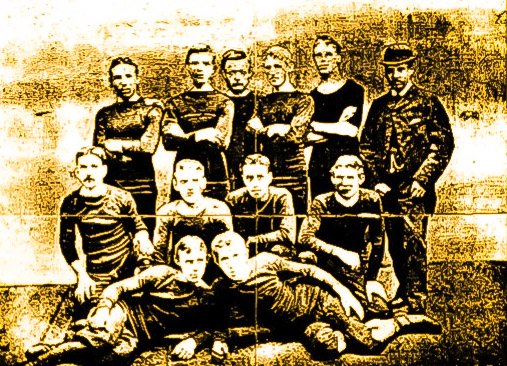
From left to right back row: J Black, A Watters, J Brauker, W Fulton (captn), C Smith, T Saunders (Umpire)
Middle Row: J Cockburn, N J Drew, A McAuley, J Fulton
Front Row: A Inglis, J Gouldie
This image has been kindly provided by Margaret Black whose great grandfather John, (back left in the picture) played for the club and was influential in its formation.
Despite only existing for 45 years, Abercorn were very much influential in shaping the game both locally and nationally in Scotland, and for the early part of their history were undoubtedly the most significant team in the town and Renfrewshire, however their fortunes would slide dramatically as the nineteenth century came to an end, and the events of local and world politics would prove to be insurmountable for the club that played in mostly blue and white hoops or stripes throughout their history.

In June 1878 along with various other clubs in the county of Renfrewshire as it was geographically determined at the time, the Abercorn board commissioned the Renfrewshire County Cup to be created following a meeting at the Star Hotel in ‘Lower King Street, Paisley’, (not the current King Street, this was located where Saucel Street is today) and the Renfrewshire County Football Association was founded, with the trophy purchased a year later from Summerton Jewellers in the town.
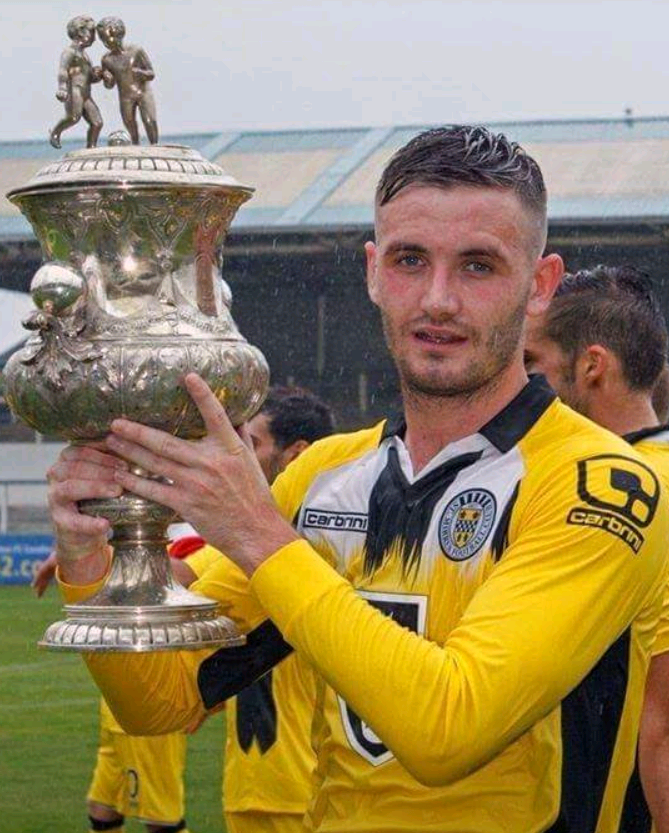
This is still the Renfrewshire Cup played for today usually between St Mirren and Morton, who were ironically not invited to the founder members committee, which included as well as Abercorn the following mixture of clubs: Arthurlie, Barrhead, Barrhead Rangers, Barrhead Thistle, Cartvale, Clydevale, Glenkilloch, Johnstone Athletic, Jordanhill, Levern, Linwood, Mearns Pollock, Thornliebank, Thornliebank Caledonia, 17th Renfrewshire Rifle Volunteers and 23rd Renfrewshire Rifle Volunteers. Incredibly only Arthurlie remain playing football beyond amateur level from these seventeen clubs today, and most don’t exist at all showing the immense staying power of Saints to survive throughout the decades.
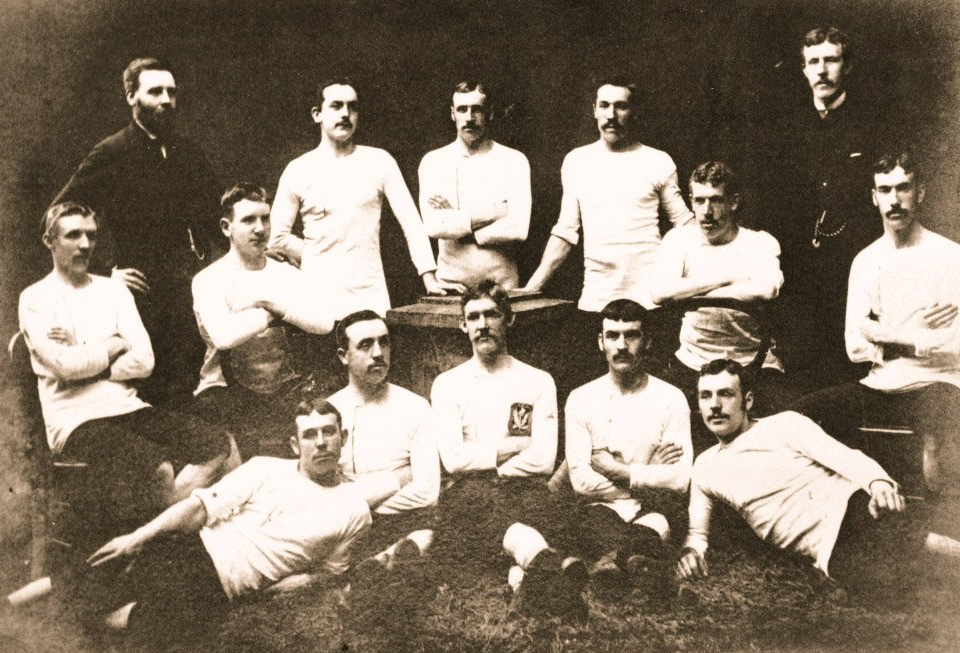
Back Row: William Crawford (President), John McIntyre, William Clark, John K Black & Robert Millar (Umpire)
Middle Row: James Fulton, George Buchanan, John Goudie & John Paterson
Front Row: Alex Inglis, Archie McAuley, William Fulton, Alex Martin & John Allander.
Photograph kindly supplied by Margaret Black
On the field of play the Abbies would win the Renfrewshire Cup on five occasions, the Paisley Charity Cup seven times, as well as securing a brace of Division Two Championships in 1896 and 1909 and also the Scottish Qualifying Cup in 1913. Abercorn also reached several Scottish Cup semi-finals, three in succession in the lead up to that first ever league season in Scotland, where they finished one place above Saints in the league table and repeated this feat the following season. The Abbies also had six full Scottish internationalists on their books, with four of them scoring for the national team, a better goal return than Saints who have had a century to beat it!

Back Row: Hugh Peebles, Thomas Ferguson, Duncan Gribbon, Gavin McLaughlin, John Adam & John Curran
Middle Row: John K Black, next 4 are unknown, James Jackson, William Howden, John Nugent & John Black
Front Row: James Reid, Robert Wallace, Archie McAulay, John Speirs, William McIntyre, Ebeneezer Rodger & Roderick Ross
Photograph kindly supplied by Margaret Black
What is also noticeable according to media reports from the time, is the hostility their supporters showed towards opponents, and on at least two occasions during the 1891/92 season opposition players were attacked by the Abbies crowd, including what would appear to be a full on attack on all eleven Celtic players after a home victory at their Underwood Park ground. Over exuberance possibly, but eye witnesses claim that the attack included assaults with fists, feet and sticks! Curiously, the subsequent report by Celtic into the matter claimed the language used was ‘blasphemous’ which is maybe the first ever recorded incidence of sectarianism in Scottish football.
The early success enjoyed by the club would not last however, when fate would deal them a cruel hand and their own refusal to turn professional accelerated their decline into the football abyss. In 1893 both Abercorn and Clyde were voted out of the top league for failing to embrace professionalism, but they once again led a pioneering role within the game when along with clubs such as Hibernian, Motherwell, Morton and Partick Thistle became founder members of the Second Division, meaning they are the only club to have started both original divisions in the Scottish game.

After winning this second tier in 1895/96, Abercorn returned to the first division, but finished bottom on only three points and this would be the last occasion they graced the top flight in Scotland during their short history. This is despite winning the second division again in 1908/09, but the Abbies failed to get the required votes at the election process of the top division clubs, with accusatory fingers pointed at Saints role behind the scenes in this seemingly unjust decision, however once again the ‘other’ Paisley club had stated their unequivocal intention to remain amateur and this was probably the deciding factor in the outcome.
The fate of Abercorn is indelibly linked to St Mirren however, and it is widely accepted that the two clubs enjoyed a fractured relationship. In 1880, a letter to the local press in Paisley suggested that all was not well within the very early days of football in the town, and indeed the accusation from inside St Mirren Park was that Abercorn felt Saints were in fact “beneath” the Abbies, who had failed to respond to communications from Westmarch regarding arranging fixtures!

By 1908, the tables had turned however as Saints had established themselves as the dominant side in the town and county, and having reached their first ever Scottish Cup final were one of the top sides in Scotland. The agenda of Saints board at the time seemed clear, to hinder any potential recovery by Abercorn, and with the clubs playing in different divisions again, the Buddies resorted to organising home matches at the same time as Abercorn to reduce their rivals’ gate numbers, resulting in a pleading letter to Love Street from the Abercorn board to cease this activity, which Saints eventually did.

The popular theory is that Saints wanted rid of Abercorn to clean up the football support within the town, however during the 1892 New Year’s Day Paisley Charity Cup final at Underwood Park, then home of the Abbies which also housed a Scotland international match, twenty two year old St Mirren captain and Scotland international inside left James Dunlop suffered a deep cut to his knee from a piece of glass thrown onto the playing field by an Abercorn spectator, and would die from the wound ten days later in the Paisley Infirmary after tetanus set in. It is pure speculation of course, but could Saints board over the next years in some way have blamed the death of their brilliant captain on their rivals or held a grudge about the alleged snobbery towards Saints from their Paisley counterparts?
We will probably never find out, but accusations from Abercorn against St Mirren that they were continuing to influence behind the scenes against their rivals own interests in both vital football league and also town council votes were rife at the time. Local politicians were willingly shaping the future of football in the town in favour of St Mirren was the suggestion, and it is generally accepted that there was an element of fact in this.
Looking at the board members of each club however, it seems that this successful political interference from Saints would be unlikely. Throughout their history, Abercorn enjoyed the support of a mixture of wealthy and significant patrons of the town, including representatives of both the Coats and Clark families (biggest employer in the town and worldwide industrial tycoons) on their board up to and including Sir Thomas Coats himself who was MP for Paisley at the time. For a period in the 1890’s, Lord Provost McGowan of the Paisley burgh also sat on their board, as well as ex Provost Cochrane. The Abbies could also count on various Lords and knights who held honorary positions at the club to speak on their behalf, and although Saints had similar appointments earlier in their history, this ceased at the turn of the 20th century. It seems improbable that Saints held more boardroom sway than Abercorn at any point of the Abbies history.

Whether true or not, the outcomes against the Abbies in these seemingly democratic processes played a significant part in the end of the club, with Abercorn having no fewer than six different grounds in their brief history. What’s this got to do with Saints you ask, well the St Mirren board at the time were accused of influencing a Paisley town council vote to end the lease on Abercorn’s last ground at New Ralston Park in 1920 (the site of Tesco in East Lane today) with the official reason given as an Ice Rink would be built in its place, which just happened to only start construction some four years later by which time Abercorn were no more. As stated already, it is highly debatable if this could have happened given the board appointments of each club.
Also in defence of Saints was the advent of WWI in 1914 meaning the second division was temporarily scrapped the following year, leaving Abercorn playing friendly matches and regional league games during and immediately after the war, until the lease at New Ralston Park ran its course. Starved of vital income and perhaps the appetite for a second team in Paisley had just waned over the years, the club faced almost certain extinction unless new land could be found within Paisley to house the football club.
Unfortunately Abercorn were unable to find such a replacement home in the town, and although they retained league registration status and played once in the Scottish Cup during 1921, they were officially disbarred from Scottish football on the 29th March 1922 for failing to acquire a suitable permanent ground, although it is now accepted that they were actually defunct in 1920 after they played their last league match.
From 1908 an annual dinner was held in the town to celebrate Abercorn and their place in Paisley, an event which continued after their demise; however the tradition stopped on Friday the tenth of February 1939 due to the lack of available living supporters, regrettably consigning Abercorn Football Club almost entirely to history, nothing more than a sad footnote of competitive sport in Paisley despite the re-emergence of an amateur side named after them in 2009.


Back Row: John Baillie, James Barr, James Pollock, Robert Stirling, William Barr & Archibald Hunter
Second Row: David Barr, James Cochran, George Coghill, William Kelso, James Lambie & William Ferguson
Third Row: John Blackwood, John K Black, John Allander, John Cockburn, John Goudie, William Fulton & James Brauker
Front Row: Alexander Martin & James Hagan
Photograph kindly supplied by Margaret Black
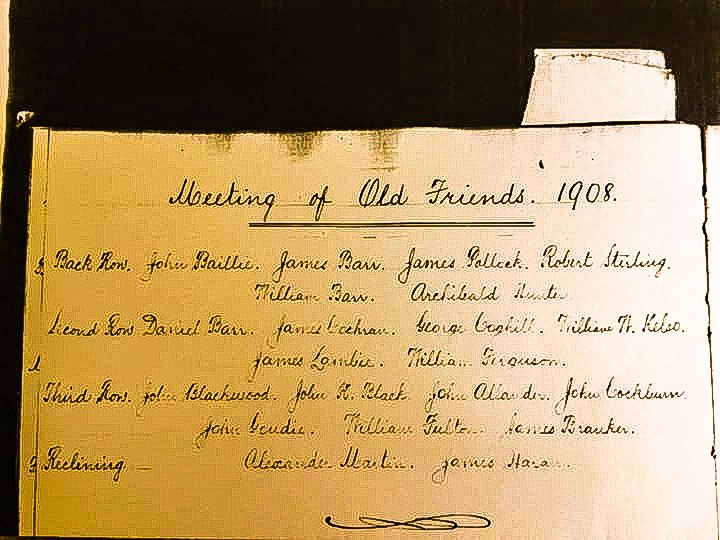
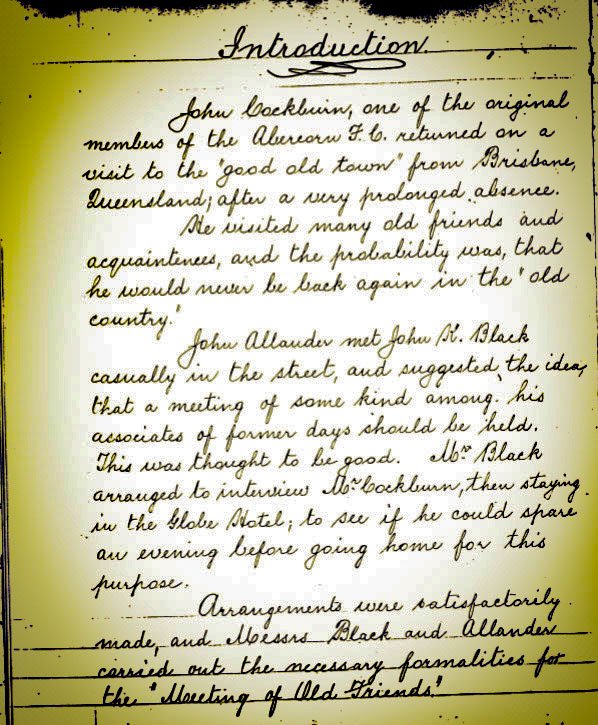
Handwritten notes from the 1908 meeting, kindly supplied by Margaret Black
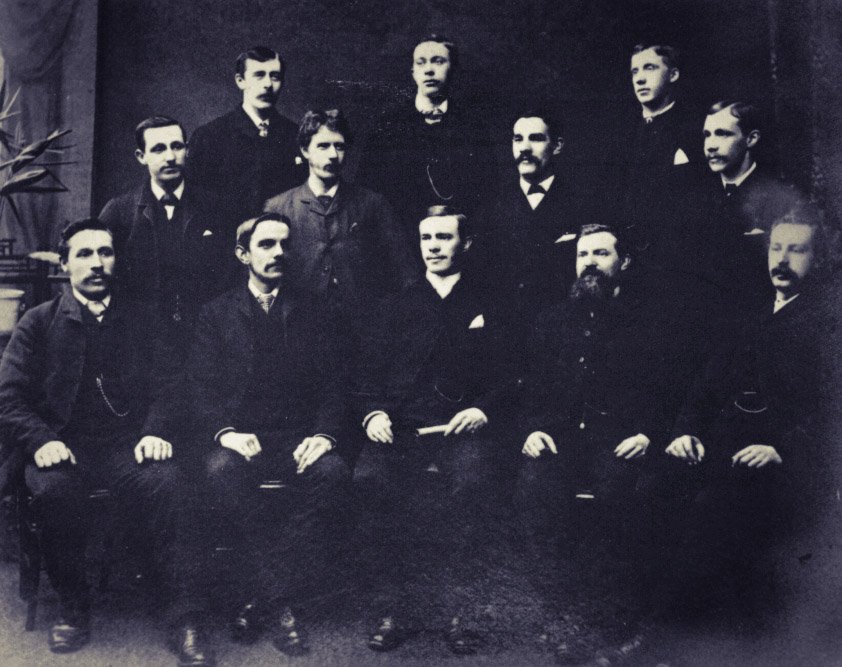
Back Row: William McTaggart, Thomas McCrumlish & James Stewart
Middle Row: Peter Craig, Lauchlan McTaggart, James Maxwell & George Orr
Front Row: John K Black, George Coghill, Dr Thomas Watt (Lecturer), Archie Robin & James Gemmell
Photograph kindly supplied by Margaret Black
Additional Information
Year Formed: 1877
Colours: Blue and white hoops or stripes.
First Match against Saints: 16th February 1878. Abercorn 0-7 St Mirren
First League Match against Saints: 20th September 1890, St Mirren 4-2 Abercorn. (Westmarch Ground, Paisley)
Last ever meeting: 24th October 1896, Abercorn 3-2 St Mirren. (Underwood Park, Paisley)
Saints competitive record against Abercorn
| Played | Won | Drawn | Lost | For | Against |
| 8 | 4 | 1 | 3 | 18 | 16 |
Saints Scorers in fixture
| Player | Total Goals |
| Hugh Morgan | 2 |
| James Dunlop | 2 |
| Mathew Mullen | 2 |
| Robert Milne | 2 |
| ? Shearer (1892) | 1 |
| ? Walker (1896) | 1 |
| Archie Brash | 1 |
| James McAulay | 1 |
| James McLean | 1 |
| James Morrison (1890-92) | 1 |
| John Douglas | 1 |
| Michael McAvoy | 1 |
| Sandy Wylie | 1 |
| Walter Shaw | 1 |
Grounds used by Abercorn
| Name of Ground | Location | Years Active | Capacity |
| East Park | Corner of Seedhill Road & Mill Street, Paisley | 1877-1889 | UNK |
| Blackstoun Park | Well Street, Paisley | 1879-1889 | UNK |
| *Thistle Park | Greenhill Rd, Paisley | 1887-1889 | 5000 |
| Underwood Park | 46 Underwood Rd, Paisley (Currently Roadside Vehicles Services Ltd) | 1889-1899 | 7500 |
| Old Ralston Park | Glasgow Road (Currently Tesco Car Park) | 1899-1909 | 5000 |
| New Ralston Park | East Lane, Paisley. (Currently Tesco) | 1909-1920 | 7000 |
*Blackstoun Park & Thistle Park listed as grounds for Abercorn FC during this period.

International Players
1. Neil Munro 2 Caps (2 goals)
10/3/1888 – Scotland 5-1 Wales (1)
13/4/1880 – England 2-3 Scotland (1)
2. Bob McCormack 1 cap (1 goal)
10/4/1886 – Scotland 4-1 Wales (1)
3. John Gouldie 1 cap (1 goal)
26/1/1884 – Ireland 0-5 Scotland (1)
4. Robert Buchanan 1 cap (1 goal)
21/3/1891 – Wales 3-4 Scotland (1)
5. James Johnston 1 cap
10/3/1888 – Scotland 5-1 Wales
6. William Fulton 1 cap
26/1/1884 – Ireland 0-5 Scotland